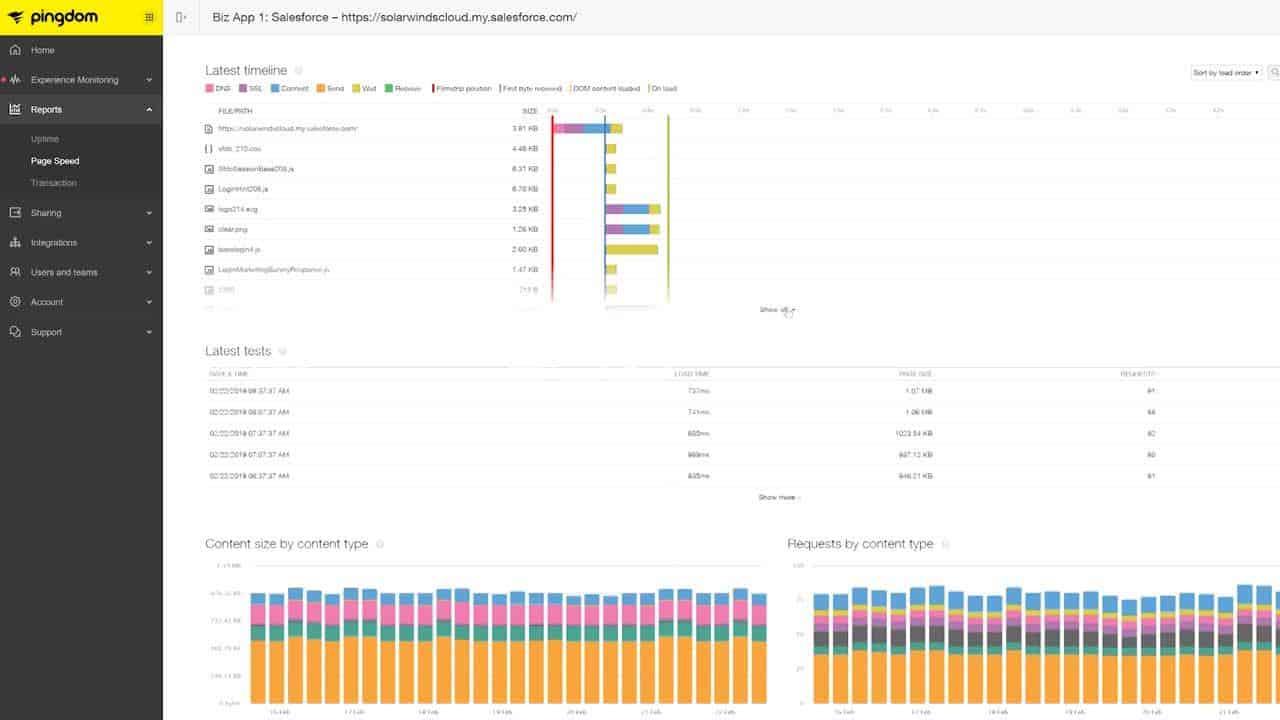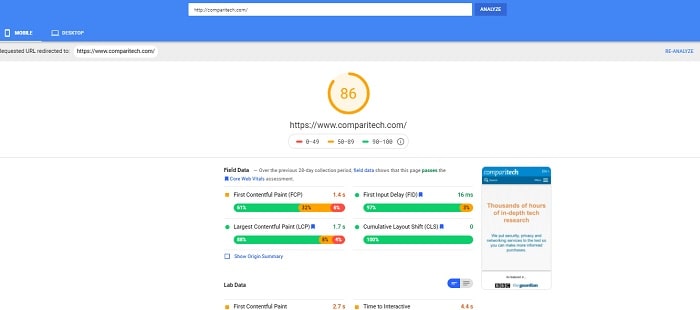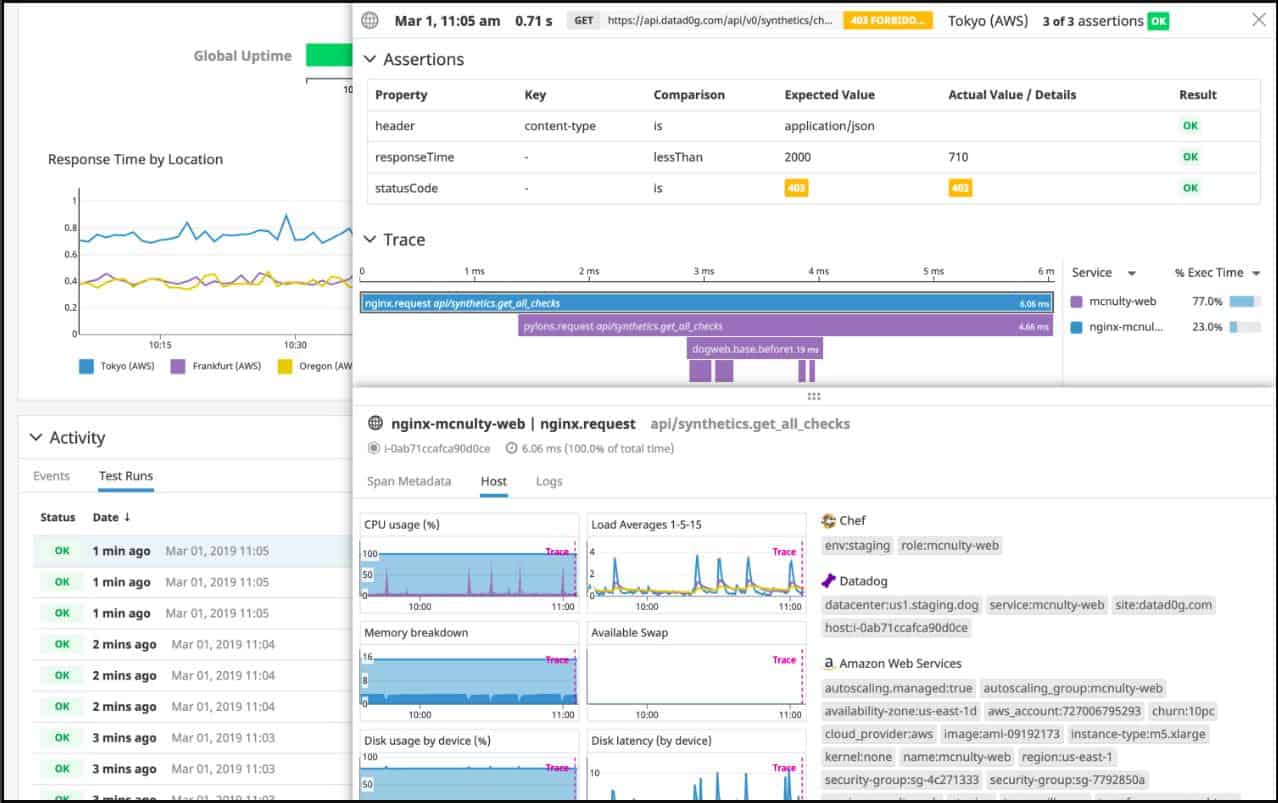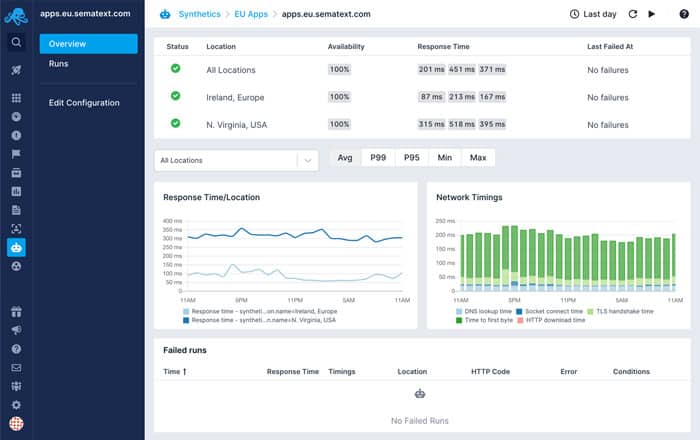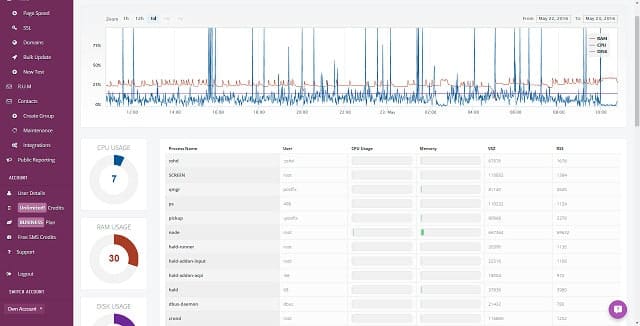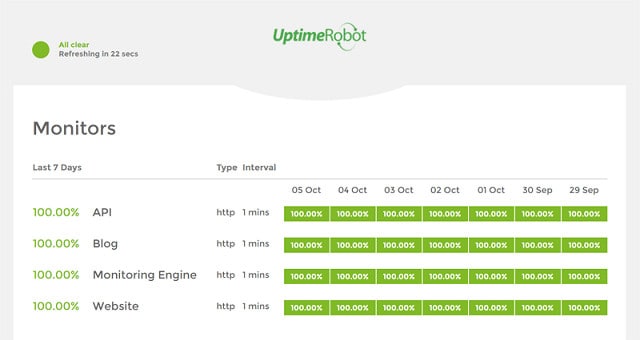SmokePing is a free, open source project. The tool offers a graphical interpretation of several Ping runs that give information about the quality of a connection over the Internet. This method of testing is very important for examining the availability and response times of websites. These factors are very important and they form the key metrics behind user experience (UX). The issue of UX is very important because a website can lose potential customers if its pages take too long to display in the browsers of visitors.
Uptime monitors and response time testers are in high demand now that the World Wide Web has become a cut-throat marketplace. So, there are many alternatives to SmokePing that have appeared to cater to this lucrative market.
Here is our list of the best SmokePing alternatives:
- Pingdom Synthetic Monitoring EDITOR’S CHOICE A Ping service to check for a website’s uptime. This is a cloud-based system that launches tests from more than 100 different locations around the world. Get a 14-day free trial.
- Site24x7 Website Monitoring (FREE TRIAL) This paid package offers Synthetic Monitoring services, which include availability and response time checks that can be launched from 120 different locations around the globe. Start a 30-day free trial.
- Google PageSpeed Insights A free response time testing service run online with a large number of different loading metrics.
- Datadog Synthetic Monitoring A cloud-based website and page testing tool that launches tests from several locations. Examines uptime, response times, load times, and load errors.
- Sematext Synthetics Performs tests on websites and pages with HTTP and browser access from locations around the globe.
- StatusCake Website availability and performance monitoring from 28 locations around the world.
- Uptime Robot Available in free and paid versions that offer real-time performance monitoring and metric storage for historical data analysis.
All about Ping
At the heart of SmokePing is a network utility that is available for free and built into every operating system. The Internet is defined by the Internet Protocol and its related standards. One system that is very closely related to the Internet Protocol is the Internet Control Message Protocol (ICMP). Ping is a method of using the ICMP facilities to test the speed and reliability of a path across the internet.
The Ping utility is available to any computer connected to a network. It sends out a series of ICMP packets to a named destination. That destination can be given either as an IP address or a URL (a web address). The message provokes a response from the destination and the Ping utility records the time it took for that response to arrive back.
The time measurement is called roundtrip time (RTT). The Ping system sends several packets and measures the response of each. On Windows, the default number of transmissions is four and it is five on Unix and Unix-like systems. That number can be altered by a variable in the command.
Once all of the tests have been run, Ping presents the minimum, maximum, and average RTT for the run. These figures are important because they express a factor known as jitter. Irregular transmissions can make websites and applications difficult to deliver, especially interactive systems, such as video conferencing or VoIP. The summary of Ping also notes the number of packets that got lost.
SmokePing and response time monitors
There are many tools available today that measure response times and record uptime for websites and most of them use Ping.
SmokePing has an option to test a destination from five different locations. This has become a very important test condition and newer uptime monitors test from up to 60 or 70 locations. Uptime monitors run ping constantly to a tested address and alert the site owner when a Ping test fails because that indicates that the site has gone down.
Many response time monitors offer the option of having tests run through an actual browser and they offer many more metrics than just the time it took for the request for a web page to be responded to.
As SmokePing is free to use, there is nothing to lose by downloading the system and trying it out. SmokePing is delivered as a TAR file, which installs on Unix and Unix-like operating systems. That means it will also run on Linux and macOS but not Windows. The latest version is 2.7.3, which was released in December 2018.
More sophisticated uptime and response time monitors are usually available as edge services. These are delivered from the cloud. Services that are able to launch tests from many locations are particularly useful and systems that can continuously issue Ping tests to a destination operate as uptime monitors.
The best alternatives to SmokePing
Our investigation of alternatives to SmokePing focused on uptime monitors that use Ping or other methods to issue checks on website availability.
Our methodology for selecting a SmokePing alternative
We reviewed the market for connection testers like SmokePing and analyzed the options based on the following criteria:
- Recursive Ping
- A time-series graph of results
- Page loading metrics for websites
- Alerts for response timeout
- Choice of launch location
- A free tool or a free trial to test the tool without risking money
- A paid tool that is worth paying for or a free tool that is worth using
Using this set of criteria, we looked for a range of connection testers and included some loading speed testers.
You can find out more about each of these tools in the following sections.
1. Pingdom EDITOR’S CHOICE
Pingdom, from SolarWinds, is an online service that tests a website’s availability with Ping from more than 100 locations around the world. The service offers two subscription plans. These are Synthetic Monitoring and Real User Monitoring. The Synthetic Monitoring system is the most like SmokePing in that it is based on Ping tests.
Key Features:
- Online System: Access the console through a Web browser
- 100 Launch Locations: Tests for CDNs and caches
- Availability Testing: Uptime monitoring
- Downtime Recheck: Confirms unavailability before raising an alert
- Event Logging: Useful for proof of an SLA breach
Why do we recommend it?
Pingdom Synthetic Monitoring provides a range of Website and mobile app checking tools with its availability test as its most basic service. Apart from the uptime test, the Synthetic Monitoring plan offers advanced monitors, which include load timers for page elements and performance tracking for interactive elements.
Tests are issued periodically and if Pingdom fails to get a response, it double checks and then raises an alert. Alerts can be graded by severity and the administrator has the option of setting the system to inform key staff by email or SMS when an alert condition arises.
Every test is logged, so webmasters can see other details, such as response times and jitter. Those logs provide source material for historical analysis of performance. Successful tests lead to further probes to identify the load times of elements on the target site.
Uptime monitoring and response time tests use different methods for measuring performance. While the uptime monitoring system targets a URL and so an entire site, the response time monitor is launched for tests on a specific page. Those response time tests can also be targeted at a specific process on the web application server.
Response time tests are useful for developers when creating new pages or features on a site. System managers can use Pingdom to check on the speed of the new page or feature before signing off on its completion.
Who is it recommended for?
The Pingdom service is suitable for any business that runs a website. There is no point in going to the effort to create a website and make it public if its server goes down or its code become corrupted. Therefore, just the basic availability check is a must-have service.
Pros:
- Continuous Uptime Monitoring: Choose the frequency and set up the Ping tests to run around the clock
- Easy to Use: Lives in the cloud, meaning no onboarding or complicated setup
- Page Speed Monitoring: Logs the load time for important page elements
- Alerts for Performance Issues: Can be sent by email or SMS, and be integrated into custom solutions via API
- Root Cause Analysis: Assists admins in fixing issues quickly
Cons:
- No Self-Hosting Option: Only available as a SaaS package
As an online service, Pingdom is charged for by subscription. The rate paid for the service is levied monthly and depends on the frequency of tests selected by the subscriber. The service is also offered at an annual rate, which works out cheaper per month than the monthly subscription periods. You can get a 14-day free trial of Pingdom.
EDITOR'S CHOICE
Pingdom is our top choice for an alternative to SmokePing because it includes all of the SmokePing functionality but with more service options and more testing locations. The uptime monitoring service of Pingdom runs from more than 60 locations, which beats the five locations offered by SmokePing. The response time tests included in the Synthetic Modeling plan of Pingdom don’t have an equivalent in SmokePing.
Download: Start 14-day FREE Trial
Official Site: https://pingdom.com/sign-up
OS: Cloud-based
2. Site24x7 Website Monitoring (FREE TRIAL)
Site24x7 Website Monitoring provides a Synthetic Monitoring service that offers a range of test opportunities, including a record and replay method to assemble test scripts. The company maintains cloud servers in 130 locations around the world and the users of the Synthetic Monitoring service can choose which of them to launch their tests from.
Key Features:
- Synthetic Monitoring: Automated performance tests
- Real User Monitoring: Records web page element responses
- 130 Test Launch Locations: Test a site’s delivery to different parts of the world
- Availability Monitoring: Also provides response times
Why do we recommend it?
The utility in the Site24x7 Website Monitoring package that most closely reflects the services of SmokePing is its availability tester. This can be set up to run from multiple locations at a specified frequency. The highest frequency available is every 30 seconds and the tester will run continuously, reporting when a test fails.
There are two types of tests in the package: repeated tests and functional testing. For example, you would set up an availability test to run on a schedule, possibly continuously. However, if you are implementing a walkthrough to validate new interactive features in a site, you would be more likely to run that test on demand maybe only once or twice.
The Website Monitoring package also provides Real User Monitoring. This records the events that occur when a website is live. It will raise an alert if the system detects an error in the website that the actions of users have provoked. This is a useful tool that continues debugging observations once acceptance testing has been completed.
One more interesting feature in the Website Monitoring package is the Digital Risk Analyzer. This scans all internet-facing assets, such as network gateways, Web applications, websites, and email systems, for vulnerabilities.
Who is it recommended for?
This is a useful package for any business that runs a website. The Site24x7 platform includes network, server, and application monitoring, and so it provides useful services for all the IT assets of a business, not just its websites. The base plan is sized and priced to suit small businesses but the service can scale up with expansion upgrades to cater to even large multinational corporations.
Pros:
- Choice of Monitors: Provides a wide range of tests for Web pages and their supporting components
- Plans Include Multiple Modules: This unit works well with the APM on the platform
- Choice of Implementation Modes: Tests can be set up to run continuously or periodically
- Record and Replay: Replicate the same walkthrough from many different launch locations
Cons:
- No On-Premises Version: Only available as a SaaS platform
The Website Monitoring plan of Site24x7 includes many other services, such as network server, application, and cloud monitoring. You can check out the Site24x7 platform with a 30-day free trial.
3. Google PageSpeed Insights
PageSpeed Insights from Google offers a free online response time check for any web page. There is no requirement to set up an account in order to use the service and you don’t even have to own the site that the tests are performed upon. Any page that can be accessed across the Web can be tested with this service, so it is a good tool for testing before a page gets included in the menu structure of a website and is still in staging.
Key Features:
- On-Demand Tests: No need to sign up for an account
- Page Loading Statistics: Observes key events and elements
- Free to Use: High quality, nonetheless
- Improvement Advice: Helpful tips
Why do we recommend it?
Google PageSpeed Insights is a free online system that ranks a page’s load time performance both from mobile devices and from Web browsers. This system is very easy to use and it provides a score for your site. The results analysis also gives you tips on what aspects of your pages need attention.
This is an on-demand service and it focuses on response times rather than availability, so it isn’t an exact match for the services offered by SmokePing.
PageSpeed Insights launches tests for rendering on mobile devices and desktops. The main feature in a results page is an overall score for the response times of that page. All results are color-coded with traffic light colors with bands of results grouped per color signal.
Test results fall into three categories. The Field Data results are not always available. This is called the Chrome User Experience Report. The Origin Summary gives an overview of the performance of all pages on the same domain as the tested page. This gives an indication of whether site settings and delivery strategies are optimized. The Lab Data section details the performance of different elements on the page. It shows results for:
- First content paint
- Time to interactive
- Speed index
- Total blocking time
- Largest content paint
- Cumulative layout shift
Below the test speeds, the results page gives advice on how to improve the speed of the page. As a page loading time test, this tool is second-to-none.
Who is it recommended for?
This tool is particularly of interest to Web designers because its reports relate to issues such as the position of images, the efficiency of code, and the use of compression, content delivery networks, and image sizing. Webmasters can measure the performance of hosting services and decide on service quality.
Pros:
- Online Tool: Access it in a website
- Page Speed Scores: Summarize technical metrics
- Offers Next Steps to Improve Your response time and overall page speed: Retest to see fix results
Cons:
- Must be Run Manually: Not a replacement for continuous monitoring
4. Datadog Synthetic Monitoring
Datadog Synthetic Monitoring goes far beyond the basic availability checks offered by SmokePing. This is a full website testing system that is ideal for running new trial pages and services before they go live and as a constant performance monitor for live websites.
Key Features:
- Cloud-Hosted: A SaaS package
- Response Time Graphs: Easy to read
- Root Cause Analysis: Look for solutions to problems
Why do we recommend it?
Datadog Synthetic Monitoring is a cloud-based service that is offered on a platform that has many system monitoring and management tools. The synthetic monitoring package provides two plans. The first of these is the API Test system, which includes availability checks that are similar to the SmokePing service.
The Datadog system is hosted in the cloud, so you don’t need to install any software in order to use it. The service is able to test web pages and services from several points around the globe, which also gives website owners insights into the efficiency of their caching and CDN services.
The Synthetic Monitoring service emulates a visitor’s journey through a site rather than tracking real users. This is good for those who want to test scenarios and spot inefficiencies before a page or a whole site goes live. Developers are able to check on response times, page load errors, and bugs in code before those problems get encountered by real users.
Who is it recommended for?
This package is accessible to any business size. The API Test service can be launched from multiple locations to check that all areas of the globe can access your website. The system gives you a choice of protocols to test with, so you aren’t limited to Ping. Datadog also offers a plan for Browser-launched tests.
Pros:
- Many Test Launch Locations: Allows for monitoring at different locations around the world
- Can Monitor Both Internally and Externally: Gives network admins a holistic view of network performance and accessibility
- Supports Auto-Discovery: Builds network topology maps on the fly
- Changes Made to the Network Adjust System Documentation: Changes are reflected in near real-time
- Alerts for Availability Test Failure: Also alerts for slow response times
Cons:
- Only a 14-day Free Trial: Would like to see a longer trial period for testing
The Datadog service includes a root-cause analysis function that drills down through the application stack to spot a supporting service that might be the reason behind any performance issue. Datadog Synthetic Modeling is available for a 14-day free trial.
5. Sematext Synthetics
Sematext Synthetics doesn’t use Ping to test website availability. Instead, it offers tests run through real browsers or an HTTP-based testing option. HTTP and browser-based testing have a much greater breadth of testing capabilities than a straightforward Ping.
The HTTP tests are much cheaper than the browser-based functions and they can be performed faster. The lower price makes them more affordable for repetitive testing at high volumes, which would provide uptime monitoring as well as performance tests.
Key Features:
- HTTP-Based: Tests availability
- Results Retention: Enables historical analysis
- Live Performance Graphs: Easy to read
Why do we recommend it?
Sematext Synthetics provides packages that combine HTTP tests and browser-based tests to check on the availability and performance of websites. The HTTP tests include a service like SmokePing. The browser-based tests perform run-throughs that activate interactive elements in a Web page. You can combine these tests to ensure constant availability and performance.
This is a cloud-based service that users subscribe to, with a rate per month. The price of a subscription varies depending on the number of HTTP and browser tests that the subscriber uses per month. Another price factor is based on the data retention period that the user chooses. The lower of the two paid plans offers 30 or 60 day retention periods and the higher plan includes the option to retain data for up to 360 days.
Who is it recommended for?
This service is a good choice for any business that runs a website. The availability tests help system administrators endure that the site is always operational and the browser-based tests are useful for Web designers because they can confirm that new elements work before releasing them.
Pros:
- Detailed Browser Checks: Lists elements that fail to load correctly
- Robust Alerting: Supports both internal and external monitoring
- Flexible Subscription Pricing: Also has a pay-as-you-go option
Cons:
- Short Trial Period: Only 14 days, would like to see a longer standard 30-day trial for testing
There is also a Pay-as-you-Go plan, which charges per HTTP test. You can try the Standard or Pro plans on a 30-day free trial.
6. StatusCake
The StatusCake website availability and performance test cloud-based service is limited to testing Linux-based web servers. However, this is a very competent service that offers tests run with Ping, HTTP, SSH, SMTP, and TCP. The service is able to test servers, websites, web pages, and SSL certificates. It also offers a virus scan service.
Key Features:
- A Range of Tests: Include uptime and page speed tests
- 43 Test Locations: Locations in 30 countries
- SSL Certificate Verification: Expiration alerts
Why do we recommend it?
The StatusCake platform provides availability checks with Ping, which is a similar level of service to the SmokePing utility. You also get page load speeds with this package and a domain and SSL monitoring system. The tool will generate an alert when a test fails and that can be forwarded to you by email or SMS.
Tests are available from 43 locations in 30 countries around the world. Test data centers are based close to the world’s population hotspots where higher access rates are likely.
Who is it recommended for?
This is a straightforward website availability testing service with some nice extras included in the package. The best news for small businesses is that there is a Free edition. This will provide availability tests for 10 pages that will repeat every five minutes plus a page speed monitor and domain and SSL checking. Paid plans get more tests and higher frequencies.
Pros:
- A Cloud-Based Tool: Can monitor both on-premise and remote sites within the same dashboard
- A Free Edition: Has limited capabilities
- Single Sign-On Environment: Eases access to the dashboard
Cons:
- Only Seven Day Trial Period: Other platforms have longer trials
StatusCake is an online service that is charged for by subscription. There are three plans available: Free, Superior, and Business. The Free service offers 10 different tests at five-minute intervals, the Superior plan includes 100 tests at one-minute intervals, and the Business plan gives 300 tests at 30-second intervals. You can get a seven-day free trial of the Superior and Business plans.
7. Uptime Robot
Uptime Robot is available in both free and paid versions. The free version checks website performance every five minutes, while the paid version, called Pro, checks on your site’s delivery speed every minute. As an online service, Uptime Robot boasts that customers can get up and running with the monitor in only 30 seconds.
Key Features:
- Free Version: Five minute monitoring intervals
- Expiration Monitoring: Checks on SSL certificate and domain expiration
- Availability Tests: Live performance graphs
Why do we recommend it?
Uptime Robot focuses on availability tests. It doesn’t provides page load speed tests or interactive feature testing. Other services in Uptime Robot packages include domain and SSL testing and a status page to show visitors when a page is unavailable. Tests are conducted with Ping or HTTP and there are also port scanning tests.
The free Uptime Robot performs 50 different checks every cycle. You get to watch the results of those tests live in the dashboard and data also gets stored for two months to enable historical performance analysis.
Who is it recommended for?
There is a Free edition for small businesses that can test the availability of up to 50 pages with a frequency of five minutes. This option provides alerts with notifications by email, SMS, or voice call. Paid plans get allowances to test more objects with higher frequencies and they also include domain and SSL testing.
Pros:
- Offers Free and Paid Versions: Caters to a wide range of business sizes
- Paid Packages Include Performance Monitoring: Alerts for problems
- Historical Data Collection and Reporting: Helpful for system performance assessment
Cons:
- Doesn’t Include Page Speed Records: Only availability checks
The paid version is customizable. You can choose from 50 to 10,000 monitors and the price increases accordingly. The subscription fee for the service can be set on a monthly payment plan or a yearly renewal charge. The annual rate works out cheaper per month than the monthly payment schedule. However many monitors you choose you get data storage for two years, additional SSL monitoring, threshold alerts, and notifications by SMS or email.
Best SmokePing Alternatives FAQS
What is SmokePing used for?
SmokePing checks connectivity and availability. It is based on the commonly-used Ping utility that is available in every operating system. Ping sends a request packet to a destination address that automatically triggers a response. After several repetitions of this cycle, Ping reports on how many of the packets were replied to and how much time elapsed between the issuance of the request and the receipt of the reply. SmokePing shows a graph of Ping results over time with a sliding window timeframe.
How often does SmokePing ping?
The standard Ping probe issues a burst of five Pings every five minutes. Other probes have different frequencies. For example, a DNS query test launches five queries every three minutes. The frequency of test runs can be altered in the configuration file for SmokePing.
What is ping tracer?
Ping tracer is more usually just called Ping. This is a function of the Internet Control Message Protocol (ICMP). This protocol isn’t aware of port numbers, so it isn’t possible to test the availability of ports with the real Ping. A variation on Ping that uses Telnet instead of ICMP is able to report on the connection availability of ports. The purpose of Ping is to test whether a remote computer is available and whether there are problems with the path to that location.



